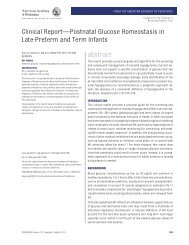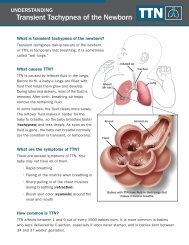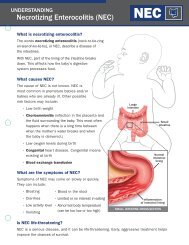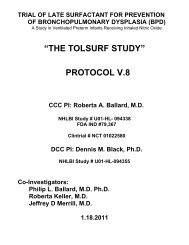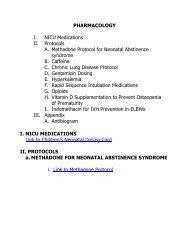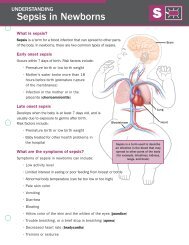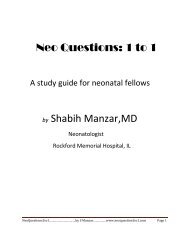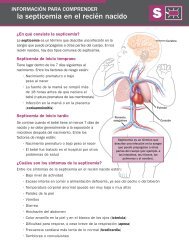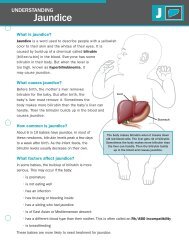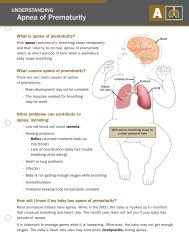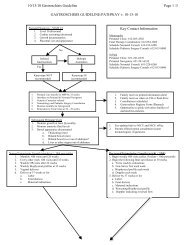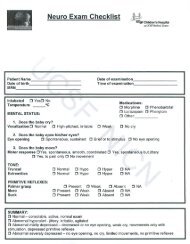Neonatal Jaundice - Associates in Newborn Medicine
Neonatal Jaundice - Associates in Newborn Medicine
Neonatal Jaundice - Associates in Newborn Medicine
You also want an ePaper? Increase the reach of your titles
YUMPU automatically turns print PDFs into web optimized ePapers that Google loves.
neonatology<br />
neonatal jaundice<br />
Table 7. The Ten Commandments<br />
for Prevent<strong>in</strong>g and Manag<strong>in</strong>g<br />
Hyperbilirub<strong>in</strong>emia<br />
1. Promote and support successful breastfeed<strong>in</strong>g.<br />
2. Establish nursery protocols for the jaundiced<br />
newborn and permit nurses to obta<strong>in</strong> TSB levels<br />
without a physician’s order.<br />
3. Measure the TSB or TcB concentrations of <strong>in</strong>fants<br />
jaundiced <strong>in</strong> the first 24 h after birth.<br />
4. Recognize that visual diagnosis of jaundice is<br />
unreliable, particularly <strong>in</strong> darkly pigmented <strong>in</strong>fants.<br />
5. Interpret all TSB levels accord<strong>in</strong>g to the <strong>in</strong>fant’s<br />
age <strong>in</strong> hours, not days.<br />
6. Do not treat a near-term (35 to 38 wk) <strong>in</strong>fant as<br />
a term <strong>in</strong>fant; a near-term <strong>in</strong>fant is at much<br />
higher risk of hyperbilirub<strong>in</strong>emia.<br />
7. Perform a predischarge systematic assessment on<br />
all <strong>in</strong>fants for the risk of severe<br />
hyperbilirub<strong>in</strong>emia.<br />
8. Provide parents with <strong>in</strong>formation about newborn<br />
jaundice.<br />
9. Provide follow-up based on the time of discharge<br />
and the risk assessment.<br />
10. When <strong>in</strong>dicated, treat the newborn with<br />
phototherapy or exchange transfusion.<br />
TSBtotal serum bilirub<strong>in</strong>, TcBtranscutaneous bilirub<strong>in</strong><br />
Repr<strong>in</strong>ted with permission from Maisels MJ. <strong>Jaundice</strong> <strong>in</strong> a newborn.<br />
How to head off an urgent situation. Contemp Pediatr. 2005;22:<br />
41–54, with permission. Adapted from Pediatrics. 2004;114:297–316.<br />
severe hyperbilirub<strong>in</strong>emia and kernicterus. Nevertheless,<br />
cl<strong>in</strong>ical judgment is required at the time of discharge. If a<br />
41-weeks’ gestation, formula-fed, nonjaundiced <strong>in</strong>fant is<br />
discharged and has no significant risk factors (Table 6), a<br />
follow-up visit after 3 or 4 days is acceptable. The absence<br />
of risk factors and any decision for a later follow up<br />
should be documented <strong>in</strong> the chart. If, on the other<br />
hand, a 36-weeks’ gestation breastfed newborn is discharged<br />
on a Friday, he or she should be seen no later<br />
than Sunday.<br />
If follow-up cannot be assured and there is a significant<br />
risk of severe hyperbilirub<strong>in</strong>emia, the cl<strong>in</strong>ician may<br />
need to delay discharge. If weekend follow-up is difficult<br />
or impossible, a reasonable option is to have the <strong>in</strong>fant<br />
brought to a laboratory for a bilirub<strong>in</strong> measurement (or a<br />
transcutaneous bilirub<strong>in</strong> measurement).<br />
Management of <strong>Jaundice</strong> <strong>in</strong> the Infant<br />
Interpret<strong>in</strong>g Serum Bilirub<strong>in</strong> Levels<br />
TSB (or transcutaneous bilirub<strong>in</strong> [TcB]) concentrations<br />
generally peak by the third to fifth day after birth (Fig.<br />
2 and Fig. 1-E). (The latter figure is available only <strong>in</strong> the<br />
onl<strong>in</strong>e edition of this article.) In the past, when newborns<br />
rema<strong>in</strong>ed <strong>in</strong> the hospital for 3 or 4 days, jaundiced babies<br />
could be identified before discharge and appropriately<br />
evaluated and treated. Today, because almost all <strong>in</strong>fants<br />
delivered vag<strong>in</strong>ally leave the hospital before they are<br />
48 hours old, the bilirub<strong>in</strong> concentration peaks after<br />
discharge. Because the TSB has not yet peaked at the<br />
time of discharge, the AAP provides str<strong>in</strong>gent guidel<strong>in</strong>es<br />
for follow-up of all <strong>in</strong>fants discharged before 72 hours of<br />
age: They should be seen with<strong>in</strong> 2 days of discharge.<br />
In addition, it is essential that all TSB values be<br />
<strong>in</strong>terpreted <strong>in</strong> terms of the <strong>in</strong>fant’s age <strong>in</strong> hours and not<br />
<strong>in</strong> days. Although cl<strong>in</strong>icians often talk about a TSB<br />
concentration on day 2 or day 3, Figure 2 (and Figure<br />
1-E <strong>in</strong> the onl<strong>in</strong>e edition) shows how mislead<strong>in</strong>g this<br />
thought process can be. A TSB of 8 mg/dL (136.8<br />
mcmol/L) at 24.1 hours is above the 95th percentile and<br />
calls for evaluation and close follow-up, whereas the same<br />
level at 47.9 hours is <strong>in</strong> the low-risk zone (Fig. 2) and<br />
probably warrants no further concern. Yet, both values<br />
occur on postnatal day 2. In the case, the TSB value at<br />
25 hours was 7.5 mg/dL (128.3 mcmol/L), very close<br />
to the 95th percentile. Consideration should have been<br />
given to additional <strong>in</strong>vestigations to try to determ<strong>in</strong>e why<br />
the <strong>in</strong>fant was jaundiced, a subsequent TSB should have<br />
been measured with<strong>in</strong> 24 hours, and follow-up should<br />
have been scheduled no later than 48 hours after discharge.<br />
When to Seek a Cause for <strong>Jaundice</strong><br />
In some <strong>in</strong>fants, the cause of hyperbilirub<strong>in</strong>emia is apparent<br />
from the history and physical exam<strong>in</strong>ation f<strong>in</strong>d<strong>in</strong>gs.<br />
For example, jaundice <strong>in</strong> a severely bruised <strong>in</strong>fant needs<br />
no further explanation, nor is there a need to <strong>in</strong>vestigate<br />
why a 5-day-old breastfed <strong>in</strong>fant has a TSB value of<br />
15 mg/dL (256.5 mcmol/L). On the other hand, if the<br />
TSB concentration is above the 95th percentile or ris<strong>in</strong>g<br />
rapidly and cross<strong>in</strong>g percentiles (Fig. 2 and Fig.1-E <strong>in</strong> the<br />
onl<strong>in</strong>e edition), and this cannot be readily expla<strong>in</strong>ed by<br />
the history and physical exam<strong>in</strong>ation results, certa<strong>in</strong> laboratory<br />
tests should be performed (Table 8).<br />
Predict<strong>in</strong>g the Risk of Hyperbilirub<strong>in</strong>emia<br />
Before discharge, every newborn needs to be assessed for<br />
the risk of subsequent severe hyperbilirub<strong>in</strong>emia. This<br />
can be accomplished by us<strong>in</strong>g cl<strong>in</strong>ical criteria (Table 6) or<br />
measur<strong>in</strong>g a TSB or TcB concentration prior to discharge.<br />
In the case described, the <strong>in</strong>fant had several risk<br />
factors for hyperbilirub<strong>in</strong>emia, and his TSB measured at<br />
26 hours was <strong>in</strong> the high <strong>in</strong>termediate-risk zone (Fig. 2),<br />
448 Pediatrics <strong>in</strong> Review Vol.27 No.12 December 2006<br />
Downloaded from http://peds<strong>in</strong>review.aappublications.org by J Michael Coleman on June 4, 2010



